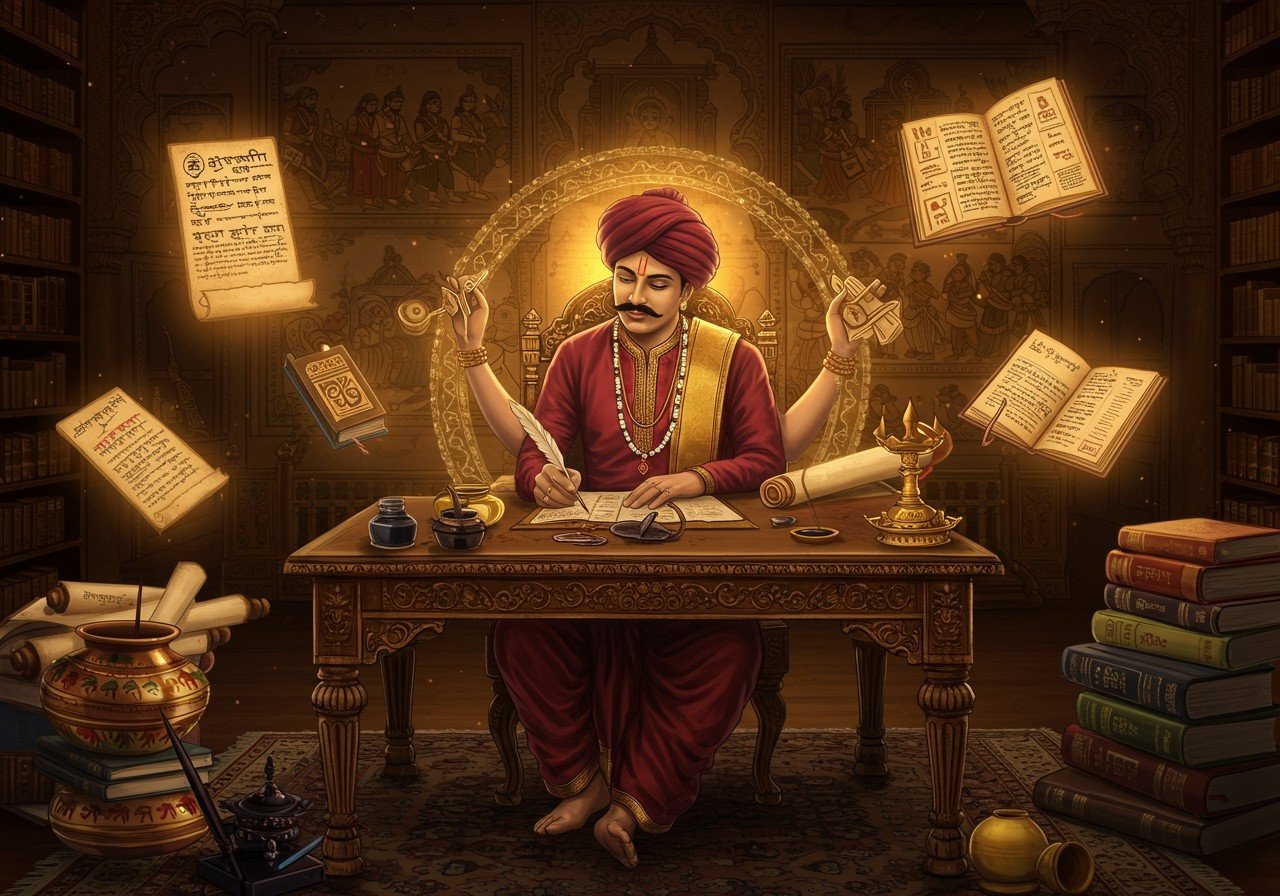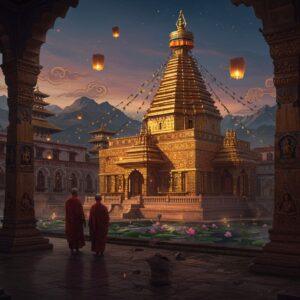
The Kayastha community holds a revered place in Indian society, known for its profound history and vibrant traditions. From ancient scribes to modern professionals, Kayasthas have made significant contributions across various fields. This exploration delves into the Kayastha community’s historical roots, societal roles, and enduring cultural significance, offering a glimpse into their rich tapestry of heritage.
Kayastha Origins: A Journey Through Time
The roots of the Kayastha community trace back to ancient India, with references found in historical texts and myths. The term “Kayastha,” derived from “kaya” (body) and “stha” (standing/existing), reflects their grounded presence in society. Ancient texts like the Manusmriti acknowledge their roles as record-keepers and administrators. Myths link them to Chitragupta, the divine scribe of Yama, the god of death, underscoring their association with knowledge and documentation. Diverse regional groups, such as North Indian Kayasthas and Bengali Kayasthas, further enrich the community’s tapestry, each with distinct customs and traditions.
Historical Influence and Contributions: Shaping India’s Narrative
Kayasthas have played pivotal roles throughout Indian history, particularly in administration and governance. During ancient empires like the Maurya and Gupta dynasties, they served as essential scribes and officials. Their expertise extended into the Mughal era, where they became influential bureaucrats and revenue officers, adapting to the changing political landscape. This adaptability continued under British rule, with Kayasthas holding key administrative positions in the civil service. Beyond administration, Kayasthas have enriched India’s cultural landscape, contributing to art, literature, and education, with luminaries like Munshi Premchand and Harivansh Rai Bachchan exemplifying their diverse talents. Today, Kayasthas continue this legacy, excelling in a wide array of modern professions.
Cultural Traditions and Practices: Preserving a Vibrant Heritage
The Kayastha community’s cultural richness shines through its unique traditions and practices. Weddings, central to their customs, feature distinct rituals like ‘kanganbandhan’ (tying of wristbands) and ‘bidhiksha’ (seeking blessings). The ‘panchang’ (traditional Hindu calendar) plays a crucial role in determining auspicious dates for these sacred ceremonies. Chitragupta Puja, observed after Diwali, holds special significance, honoring their divine patron. Traditional attire and cuisine vary across regions, showcasing the community’s diversity. Active participation in social and religious organizations underscores their commitment to cultural preservation and community welfare. Poojn.in offers a wide selection of traditional dhotis perfect for these occasions.
Kayastha Community in the Modern Era: Embracing Change, Honoring Tradition
In contemporary India, Kayasthas continue to thrive, excelling in diverse fields like education, business, and various professions. Community organizations play a vital role in supporting welfare initiatives, educational programs, and cultural events, fostering a strong sense of belonging. While embracing technology and the conveniences of modern life, including online platforms like Poojn.in for their ritual needs, Kayasthas remain deeply rooted in their traditions. The global Kayastha diaspora further exemplifies this blend, contributing to their adopted countries while maintaining strong cultural ties with India. This delicate balance between tradition and modernity, while presenting challenges, ultimately strengthens the community’s unity worldwide.
Delving Deeper into the Kayastha Legacy: A Story of Resilience and Adaptation
The Kayastha community embodies a unique blend of tradition and progress. Their journey through time reflects a remarkable ability to adapt and contribute, while preserving their rich cultural heritage. This section further explores the Kayasthas’ historical footprint, cultural practices, and ongoing relevance in modern society.
Tracing the Historical Trajectory
The Kayasthas’ historical narrative begins in the Kushan Empire, where the term “Kayastha” emerged, denoting individuals skilled in writing and record-keeping. Their presence as government officials is documented in historical texts and inscriptions. As the “writing caste,” they held crucial administrative and ministerial roles, their expertise honed through formal education in law, literature, and languages. The medieval period saw Kayasthas mastering Persian, enabling them to serve in Mughal courts, demonstrating their adaptability. Some embraced Islam, forming a distinct Muslim Kayastha community, while Bengali Kayasthas maintained their roles as landholders and political intermediaries. Under British rule, their contributions continued in clerical and administrative civil service roles. Today, Kayasthas are found across central, eastern, and northern India, excelling in professions like medicine, law, education, and engineering.
Cultural Nuances and Practices: A Celebration of Diversity
The Kayastha community’s cultural fabric is woven with diverse traditions. Their historical occupations as scribes and administrators have shaped their customs and rituals. Sub-castes and gotras, such as Sandilya, Kautilya, Garga, and Kashyap, play significant roles in marriage ceremonies.
- Lagan (Exchange of Garlands): This beautiful tradition symbolizes the union of two souls, marking the beginning of their journey together. The bride and groom exchange garlands, signifying their acceptance of each other.
- Haldi (Turmeric Ceremony): Turmeric paste, known for its auspicious and purifying properties, is applied to the bride and groom. This ceremony is believed to bless the couple with good health and fortune.
- Ganesh Puja (Worship of Lord Ganesha): Lord Ganesha, the remover of obstacles, is invoked before the wedding ceremony to ensure a smooth and blessed start to the couple’s married life. This tradition highlights the importance of seeking divine blessings.
- Saat Phere (Seven Sacred Vows): The couple takes seven rounds around the sacred fire, making vows to support and cherish each other. Each phera represents a specific promise and commitment to their relationship.
- Kanyadaan (Giving Away of the Bride): This emotional moment signifies the bride’s father entrusting his daughter to the groom. It symbolizes the transfer of responsibility and the beginning of a new chapter in her life.
Primarily Hindu, Kayasthas celebrate festivals like Holi, Diwali, Navratri, and Rama Navami with fervor. Certain sub-groups observe the Upanayana ceremony, signifying the right to study the Vedas. A unique custom involves paying homage to traditional tools like pens and inkpots, reflecting their historical association with writing and knowledge. Lord Chitragupta, revered as the divine scribe, is worshipped with deep reverence. You can find all the puja samagri you need at Poojn.in.
Kayasthas Today: Navigating the Modern World
Kayasthas successfully navigate the complexities of modern life while upholding their cherished traditions. Community organizations actively promote welfare initiatives and cultural events, ensuring the preservation of their heritage. Embracing technology and online platforms allows for convenient access to resources, including online shopping for ritual needs through websites like Poojn.in. The global Kayastha diaspora continues to contribute internationally while maintaining strong connections to their cultural roots. This ability to embrace change while honoring tradition creates a sense of unity among Kayasthas worldwide.
Poojn.in: Supporting Kayastha Rituals and Traditions
Poojn.in understands the importance of preserving cultural heritage. We offer a wide range of authentic puja items specifically for Kayastha rituals and ceremonies, delivered right to your doorstep.
Traditional Items Available at Poojn.in:
- Kushasan (Kush Grass Seat): Prepared through Vedic processes, ensuring authenticity and purity for your ceremonies.
- Jute Rope and Red Chelli Cloth: Essential materials for various Kayastha rituals, sourced with utmost care and respect for tradition. Explore our collection of clay diyas and ghats, perfect for creating a sacred ambiance during puja.
- Chamar/Chanvara (Ceremonial Whisk): Crafted with a German silver handle, adding elegance and tradition to your rituals.
Why Choose Poojn.in?
- Home Delivery: The convenience of having ritual items delivered directly to your home, saving you time and effort. Poojn.in also offers Bhoj Patra, perfect for writing mantras and prayers.
- Quality Assurance: We ensure all our products are authentic and quality-checked, meeting the highest standards of purity.
- Competitive Pricing and Discounts: Offering affordable prices and regular discounts, making ritual items accessible to everyone.
- Expert Guidance: Our team is available to provide expert guidance on product selection, ensuring you have everything you need for your ceremonies.
Easy Ordering:
- Visit www.poojn.in
- Select the required items
- Place your order online
- Contact us via phone: 03369029784
- Connect on WhatsApp: 9476142738
Honoring the Past, Embracing the Future
The Kayastha community stands as a testament to the enduring power of tradition and the embrace of progress. Their rich history, vibrant cultural practices, and adaptability have ensured their continued significance in Indian society. As Kayasthas honor their heritage and embrace the future, they contribute to a vibrant tapestry of Indian culture.
Frequently Asked Questions
What are the origins of the Kayastha community? The Kayastha community’s origins trace back to ancient India, with mythological connections to Chitragupta, the divine record-keeper. Historical texts further document their presence as scribes and administrators.
What is the historical significance of the Kayasthas? Kayasthas have played crucial roles in Indian history, serving as scribes, administrators, and officials in various kingdoms and empires. Their contributions have spanned from ancient times to the modern era.
What are some common Kayastha traditions? Kayastha traditions are rich and diverse, including unique wedding rituals, the observance of Chitragupta Puja, and the celebration of major Hindu festivals like Diwali and Holi. Regional variations add further depth to their cultural practices.
Are there any specific Kayastha ceremonies? Yes. Some Kayasthas follow the ancient Vedic thread ceremony, or Upanayana. They also hold various community-specific ceremonies and festivals throughout the year, like the Chitragupta Puja where the community pays homage to Lord Chitragupta, the divine record-keeper. These ceremonies, passed down through generations, serve to strengthen community bonds and preserve their unique heritage.
Where can I find information about the Kayastha community? You can find information by researching historical and cultural materials available online and in libraries. Additionally, there are community associations and organizations devoted to preserving Kayastha history and traditions that may offer resources. Here’s a link to an article on the Sirsi Marikamba Temple for your reading pleasure.
What are some interesting facts about Kayasthas? Traditionally known as scribes, Kayasthas have a rich history steeped in education, literacy, and administrative roles. Their unique traditions, passed down through generations, reflect their cultural identity and historical influence. Also check out this page on the Nanjangud temple.
What professions are Kayasthas traditionally associated with? Historically, Kayasthas were known for their expertise in administration and record-keeping. In the modern era, they continue to excel in diverse fields such as law, business, education, medicine, and engineering.
How do Kayasthas maintain their cultural heritage? Kayasthas preserve their cultural heritage through community gatherings, traditional ceremonies, storytelling, and the transmission of rituals and customs from one generation to the next. Active participation in community organizations and online platforms further strengthens these bonds.
Where are Kayasthas found globally? While primarily concentrated in India, Kayasthas have also established communities in other countries through migration. Wherever they reside, they often strive to maintain their cultural practices and connections to their heritage.
How is Chitragupta Puja celebrated? Chitragupta Puja is a significant festival for Kayasthas, honoring Lord Chitragupta. Rituals often involve writing down personal reflections and seeking blessings for prosperity and wisdom. This observance underscores the importance of self-reflection and accountability.


